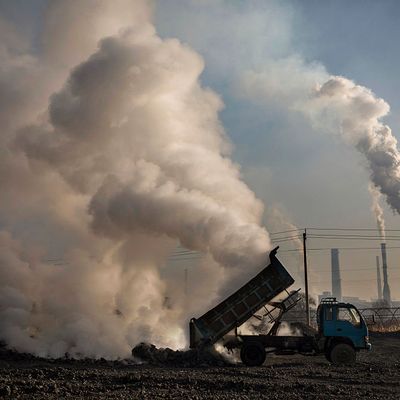
In December 2015, 196 U.N. member nations signed the nonbinding Paris Climate Agreement, promising that decades of ignoring the problem of climate change would be summarily reversed, and that the world economy would keep warming to 1.5 degrees celsius above preindustrial levels. Four years later, that promise has been ignored: According to the United Nations’ annual Emissions Gap Report, global temperatures are currently on pace to rise by as much as 3.9 degrees celsius (7 degrees fahrenheit) by 2100.
The study, which estimates for the first time “how large annual cuts would need to be from 2020 to 2030 to stay on track to meeting the Paris goals,” states that emissions must decline by 7.6 percent every year for the next decade to stay on target. Meanwhile, greenhouse gas emissions have grown 1.5 percent worldwide over the past decade — almost half of which took place after the landmark 2015 agreement. Last year, fossil-fuel emissions of CO2 in the United States bumped up 2.7 percent, due to the Trump administration’s pending retreat from the Paris agreement and its very real war on climate regulation.
“The summary findings are bleak,” the report states, as safer levels of warming require immediate and substantial cuts, which are unlikely in the current political and economic climates of the two biggest emitters, the United States and China, which boosted emissions by 4.7 percent last year. “Every year of delay beyond 2020 brings a need for faster cuts, which become increasingly expensive, unlikely, and impractical. Delays will also quickly put the 1.5 C goal out of reach.” Even if all the countries that signed the 2015 agreement cut emissions according to its Parisian goals, the U.N. report released Tuesday estimates that global temperatures would still rise 3.2 degrees Celsius.
With the effects of a hotter, more chaotic planet already in motion with just one degree of warming baked in, close to four degrees would bring a world drastically altered from our own. As the Guardian notes:
The last time the world was this hot was 15 million years ago during the miocene, when intense volcanic eruptions in western North America emitted vast quantities of CO2. Sea levels rose some 40 metres higher than today and lush forests grew in Antarctica and the Arctic. However, that global heating took place over many thousands of years. Even at its most rapid, the rise in CO2 emissions occurred at a rate 1,000 times slower than ours has since the start of the Industrial Revolution. That gave animals and plants time to adapt to new conditions and, crucially, ecosystems had not been degraded by humans.
Though the forecast is bleak — particularly if the Trump administration sprawls out into the new decade, further delaying anything close to meaningful U.S. action — it is not without (mitigated) hope. At least 70 countries have informed the U.N. that they plan to implement more serious emissions reductions in the new year. Cities and states with substantial economies have passed aggressive climate bills, proving that executive inaction doesn’t equate to a total loss. In September, 350.org reported that $11 trillion of institutional investment has been shifted away from fossil-fuel companies.
And as New York’s David Wallace-Wells argued in September, the climate-protest movements that have surged since the last bleak U.N. report represent “a sea change in public concern.” As of last fall:
The British protest movement Extinction Rebellion had not yet launched, which it would in November, blockading five bridges across the Thames and effectively stopping traffic in parts of London; hardly any American had heard of the Sunrise movement, which would make itself known when it occupied Nancy Pelosi’s office in November and later forced two single-issue climate town halls onto the Democratic primary calendar; Alexandria Ocasio-Cortez had not yet been elected to Congress or introduced the crusade toward a Green New Deal. It has been a dizzying year for climate mobilization, in other words, and improbably but inarguably, Greta Thunberg has become its face.
Wallace-Wells also provides a glimmer of action-oriented optimism in his 2019 book The Uninhabitable Earth: “No matter how hot it gets, no matter how fully climate change transforms the planet and the way we live on it, it will always be the case that the next decade could contain more warming, and more suffering, or less warming, and less suffering. Just how much is up to us, and always will be.”






























